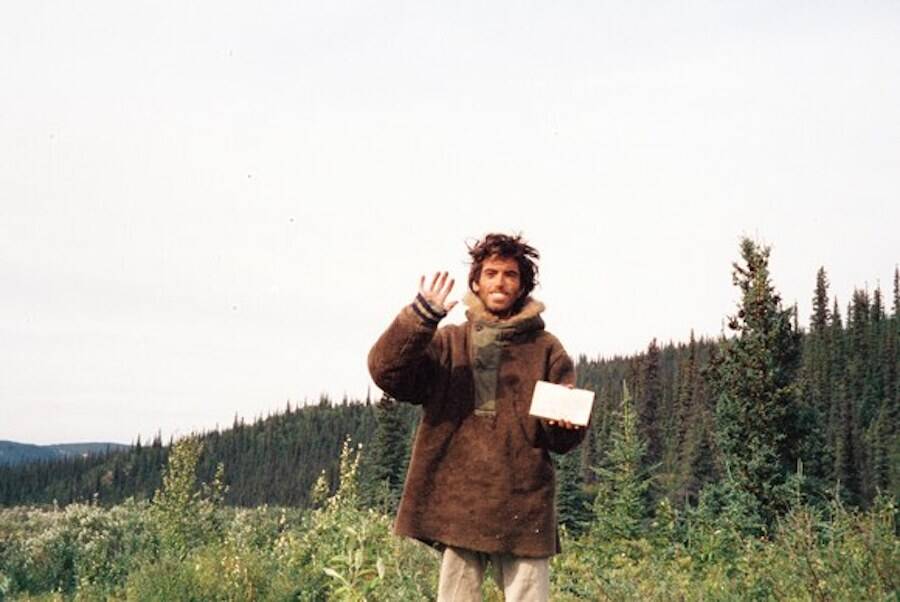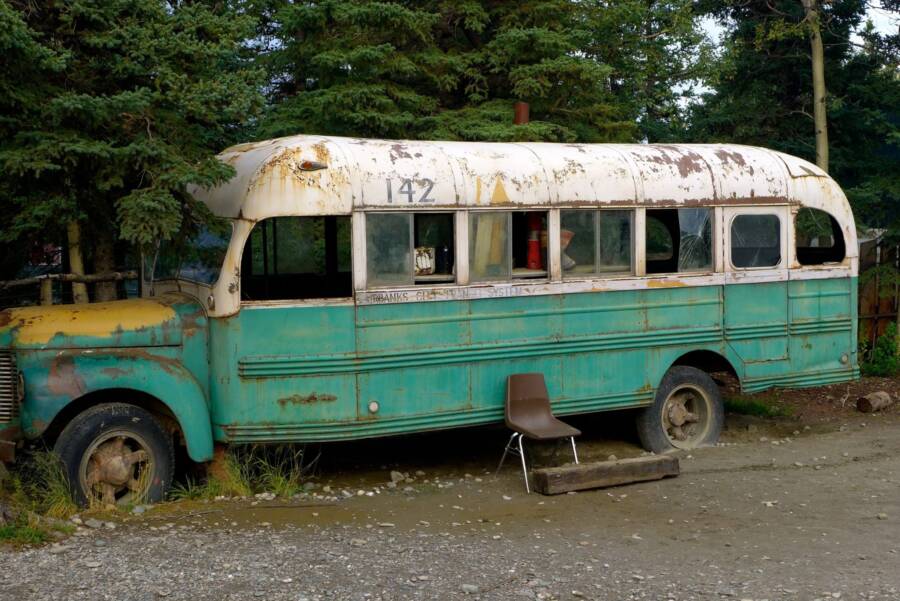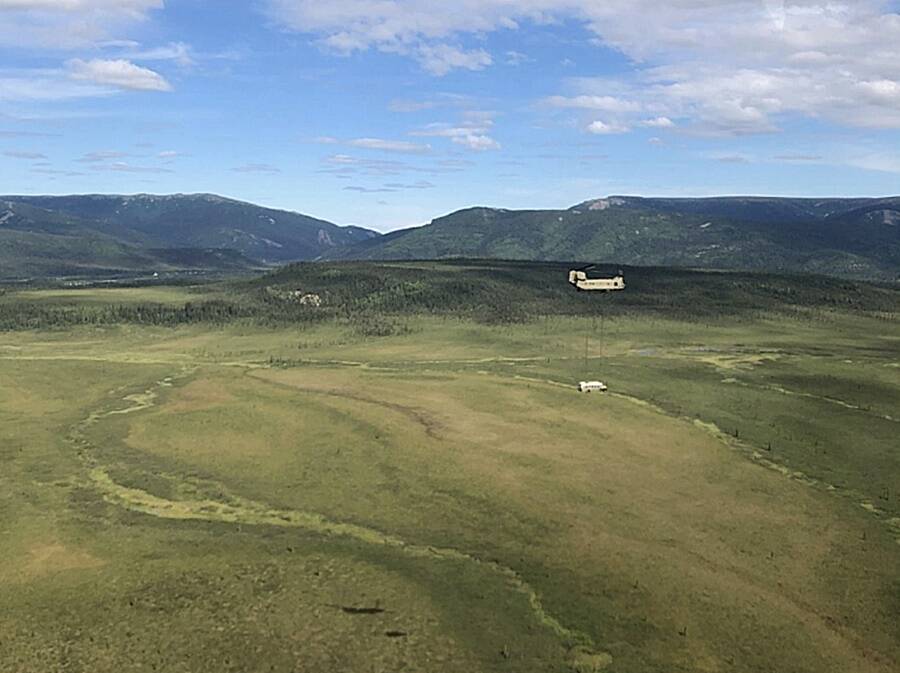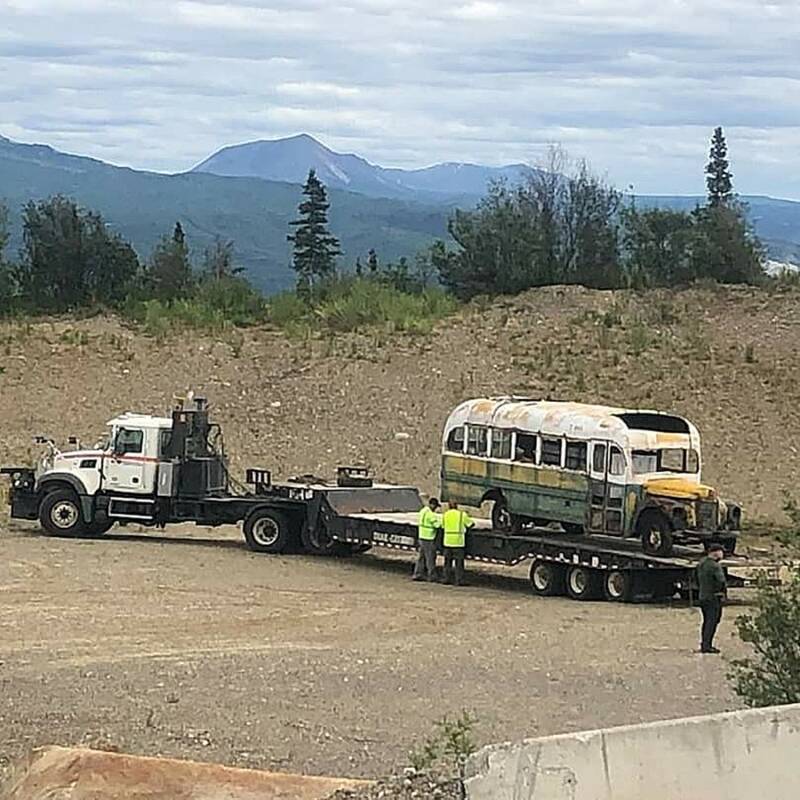At least two people died trying to reach the infamous Into The Wild bus on Alaska's Stampede Trail after hiker Chris McCandless died there in 1992.
In 1992, two moose hunters stumbled upon an abandoned bus in the middle of the Alaskan wilderness. Inside the rusty, overgrown vehicle, they found the body of 24-year-old Chris McCandless, a hitchhiker who had left everything behind to pursue an off-the-grid life in Alaska.
Since then, many have been lost, injured, and even killed attempting to retrace the young transient’s journey in hopes of reaching the infamous abandoned Fairbanks City Transit bus number 142, better known as the Into The Wild bus.

Wikimedia CommonsChris McCandless took many self-portraits, including this one in front of the abandoned bus — popularly known as the Into The Wild bus — that was his shelter.
The ominous attraction was finally removed by the state government in 2020 in a costly endeavor dubbed Operation Yutan — but not before the deaths of two hikers and the near-deaths of countless others.
The Death Of Chris McCandless
In April 1992, growing increasingly detached from his suburban life in Virginia, Chris McCandless finally decided to take the plunge. He donated his entire $24,000 savings to charity, packed a small bag of provisions, and embarked on what was supposed to be a two-year adventure across the United States.
Chris McCandless successfully hitchhiked his way from Carthage, South Dakota to Fairbanks, Alaska. A local electrician named Jim Gallien agreed to drop him off at the head of Stampede Trail on April 28 so that he could begin the trek through Denali National Park.
But by Gallien’s own account, he had “deep doubts” that McCandless would be successful in his mission to live off the land. During their encounter, he noted that McCandless seemed ill-prepared for the treacherous journey into the Alaskan wild, having only packed meager rations in a light backpack along with a pair of Wellington boots that Gallien had given him.
What’s more, the young man appeared to have little experience navigating the outdoors.

The New YorkerChris McCandless’ death in the Alaskan wilderness was made popular by the book and subsequent film Into the Wild.
Regardless, McCandless made his way to the trail. However, instead of following his route, he decided to set up camp inside of a robin-blue abandoned bus abandoned in the middle of the woods. McCandless began living off the land as he envisioned and chronicling his days in a journal he kept inside the bus.
According to his journal notes, McCandless survived off of a nine-pound bag of rice he had brought along with him. For protein, he made use of his gun and hunted small game like ptarmigan, squirrels, and geese while foraging for edible plants and wild berries.
After three months of hunting animals, picking plants, and living inside a decrepit bus with no human contact, McCandless had had enough. He packed up and began the trek back to civilization.
Unfortunately, the summer months had melted away a significant amount of snow, causing the Teklanika river that separated him from the path back out of the park to become perilously high. It was impossible for him to cross.
So, he went back to the bus. As his body began to deteriorate from malnourishment, McCandless would ultimately spend 132 days alone without help in the wilderness. On September 6, 1992, a pair of hunters stumbled upon his rotting corpse along with his journal and what was left of his meager belongings inside the abandoned bus.
Although an investigation into his death was launched after, the true cause of McCandless’ death remains largely debated.
How The Into The Wild Bus Sparked A Phenomenon

A replica of the bus used in the movie Into the Wild.
After Chris McCandless’s tragic death, journalist John Krakauer covered the story of the stranded 24-year-old in the midst of the Alaskan woods. He would eventually publish the entirety of his findings in his 1996 book titled Into the Wild.
Over the years, the book garnered cult status, rivaling the likes of other influential literature that have explored the trappings of modern society like Catcher in the Rye and On the Road.
However, experts in the McCandless case have most likened Krakauer’s book to Henry David Thoreau’s Walden, which followed the philosopher’s own self-experiment of solitary life between 1845 and 1847 while living in a one-room cabin in Massachusetts. Unsurprisingly, Thoreau was McCandless’ favorite writer, which means that McCandless could have very well gotten the inspiration for his adventure from the philosopher.
The story gained even more notoriety after the book was adapted into a film by actor-director Sean Penn in 2007, injecting McCandless’ story into the mainstream consciousness.
The Into the Wild bus where McCandless wasted away features prominently in the film and McCandless’ last photographs and has been adopted as a symbol of his life-altering adventure.
Each year, hundreds of “pilgrims” headed to the same Stampede Trail once walked by McCandless in hopes of reaching the bus still standing in the woods about 10 miles north of the Denali National Park entrance.
“There’s a pretty steady trickle all summer,” lodge owner Jon Nierenberg, who owns the EarthSong establishment right off the Stampede trail, told the Guardian. “There are different types, but for the most passionate – the ones we locals call pilgrims – it is a quasi-religious thing. They idealize McCandless. Some of the stuff they write in the journals [at the bus] is hair-raising.”
But what pulled all those people to the backcountry of Alaska? According to journalist and wilderness enthusiast Diana Saverin, who wrote about the McCandless pilgrim phenomenon, these Into the Wild hikers were likely motivated by a self-projection of their own unfulfilled lives.
“The people I encountered would always talk about freedom,” Saverin said. “I would ask, what does that mean? I had a sense that it represented a catch-all. It represented an idea of what people might want to do or be. I met one man, a consultant, who had just had a baby and who wanted to change his life to be a carpenter – but couldn’t, so took a week to visit the bus. People see McCandless as someone who just went and ‘did it’.”
But the back-to-nature trek to the Chris McCandless bus came at an invisible high cost. Since the very real challenges that McCandless himself faced during his ordeal have remained unchanged, many of these pilgrims either got hurt, lost, or were even killed in their attempt to reenact his hike. Local residents, passing hikers, and troopers often ended up having to help save these people.
In 2010, the first death of a hiker heading to the McCandless bus was recorded. A 24-year-old Swiss woman named Claire Ackermann drowned while attempting to cross the Teklanika River — the same river that had prevented McCandless’ return home.
Ackermann had been hiking with a partner from France, who told authorities that the bus, which just happened to be located across the river, was not their intended destination.
Even after the story of her death spread, the pilgrims still came, though most had come out luckier than Ackermann had. In 2013, there were two major rescues performed in the area. In May 2019, three German hikers had to be rescued. A month later, three more hikers were airlifted by a passing military helicopter.
The Mounting Death Toll Of The Into The Wild Bus

Paxson Woelber/FlickrA group of hikers recreate McCandless’ well-known portrait in front of the bus.
The most recent death was recorded in July 2019, when 24-year-old Veramika Maikamava was swept under the mighty river currents after she and her husband tried to cross the Teklanika river in their trek to the bus.
Alaska state troopers told Saverin that 75 percent of all rescues they performed in the area occurred on the Stampede Trail.
“Obviously, there’s something that draws these people out here,” one of the troopers, who wished to remain anonymous, said. “It’s some kind of internal thing within them that makes them go out to that bus. I don’t know what it is. I don’t understand. What would possess a person to follow in the tracks of someone who died because he was unprepared?”
The steady stream of trekkers hoping to attempt the same journey that got a young man killed sparked much criticism over the perceived romanticism of McCandless attempt to live in the wild without adequate preparations.
In The Beatification of Chris McCandless, Alaska-Dispatch writer Craig Medred blamed the ongoing injuries and deaths on the Stampede Trail on the public worship of the McCandless myth.
“Thanks to the magic of words, the poacher Chris McCandless was transformed in his afterlife into some sort of poor, admirable romantic soul lost in the wilds of Alaska, and now appears on the verge of becoming some sort of beloved vampire,” Medred wrote. He also ridiculed the empty soul-searching attempts by the McCandless disciples.
“More than 20 years later, it is richly ironic to think of some self-involved urban Americans, people more detached from nature than any society of humans in history, worshipping the noble, suicidal narcissist, the bum, thief and poacher Chris McCandless.”
The deaths and rescues ignited repeat debates about whether something should be done to the bus itself. On one side, some believe that it should be permanently moved to an inaccessible site, while the others advocated for building a footbridge across the river where many have almost faced death.
Whatever the consensus may be, there is no denying that the Into the Wild bus tempted more than enough lost souls in need of rescue.
Operation Yutan And The Removal Of Fairbanks Bus 142

Army National GuardOn June 18, 2020, the infamous bus was finally removed by the state government.
On June 18, 2020, Chris McCandless’ famous bus shelter was airlifted by the Army National Guard from its location to an undisclosed temporary storage site to stop hikers from endangering themselves trying to reach it.
The operation was a collaboration between the Alaska departments of transportation, natural resources, and military and veterans’ affairs. It was dubbed Operation Yutan after the company which first placed the perilous bus in the wild.
Finally, after decades of wanderers injured and dying in search of McCandless’ Into The Wild bus, the Denali borough of Alaska requested that the deadly attraction be removed for good.
“I know it’s the right thing for public safety in the area, removing the perilous attraction,” said Mayor Clay Walker of the decision. “At the same time, it’s always a little bittersweet when a piece of your history gets pulled out.”
Twelve National Guard members were deployed on site to remove the bus. Holes were cut through the floor and ceiling of the bus, enabling the crew to attach chains onto the vehicle so that it could be carried up by a heavy-lift helicopter.
In addition, the removal team also secured a suitcase inside the bus for safe transport which “holds sentimental value to the McCandless family,” read a statement released by the National Guard.

Liz Reeves de Ramos/Facebook‘I know this will spark emotions from a lot of people,’ resident Liz Reeves de Ramos wrote after sharing photos of the bus being removed.
In the same vein, Alaska’s Department of Natural Resources also put out a statement on the momentous decision, writing:
“We encourage people to enjoy Alaska’s wild areas safely, and we understand the hold this bus has had on the popular imagination…However, this is an abandoned and deteriorating vehicle that was requiring dangerous and costly rescue efforts, but more importantly, was costing some visitors their lives. I’m glad we found a safe, respectful, and economical solution to this situation.”
According to the department, there were at least 15 different search and rescue missions performed by the state between 2009 and 2017 due to travelers seeking out the famous Into The Wild bus.
As for its final resting place, the state has yet to decide where the bus will be housed permanently, though it’s possible that it will be put on official display for public viewing.
Soon, fans of the book and film may be able to see the Into The Wild bus without having to risk their lives as he and countless others did.
After learning about the Into The Wild bus, read up on the dead hikers’ bodies littering Mount Everest. Then, learn about the hikers who died horrifically in the remote wilderness in the Dyatlov Pass incident.





